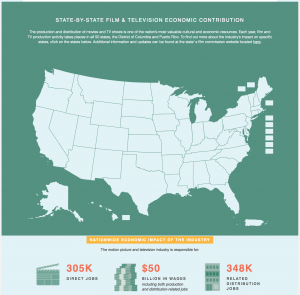MPAA Unveils Latest State-By-State Figures on Economic Impact of Film and Television Industry
In advance of Labor Day, the Motion Picture Association of America (MPAA) today released new statistics on the film and television industry’s economic impact in all 50 states, featuring an interactive map that includes state-by-state data on jobs and wages, as well as information about movies and TV shows filming locally.
In total, the film and television industry supports 1.9 million U.S. jobs and $121 billion in wages. Direct industry jobs generated $50 billion in wages, and an average salary 48% higher than the national average. That includes nearly 305,000 jobs in the core business of producing, marketing, manufacturing, and distributing motion pictures and television shows. These are high quality jobs, with a heavily unionized workforce and an average salary of $92,000, 79% higher than the average salary nationwide. Additionally, there were over 348,000 jobs in related businesses that distribute motion pictures and television shows to consumers. The industry’s direct jobs employ more people than utilities, crop production, and metal manufacturing.
While a major private sector employer, the industry is comprised largely of small businesses. Out of nearly 89,000 businesses located in every state in the country, 84% employ fewer than 10 people. Film and television also supports other businesses in other industries, making over $41 billion in payments to more than 345,000 local businesses in 2014.
The film and television industry is making a significant local impact in key states, including:
- In Georgia, the film and television industry directly employs 25,700 people and pays more than $1.7 billion in wages. There are over 2,700 motion picture and television industry businesses in Georgia, including 1,822 production-related companies. The production of Selma spent $470,000 on in-state wardrobe purchases, dry cleaning and laundry. The film also purchased $180,000 worth of lumber, hardware, and other supplies. Popular TV shows like The Walking Dead bring tourism to the area when fans flock to see filming sites.
- In Hawaii, the film and television industry directly employs over 2,200 people and pays more than $100 million in wages, and was a location for productions like Jurassic World, Hawaii Five-O, and Snowden.
- In Illinois, the film and television industry directly employs more than 19,000 people and pays over $1 billion in wages. Recent movie productions in the state include Barbershop: The Next Cut and Southside with You, and TV series Empire, Chicago Fire, and The Girlfriend Experience.
- In New York, the film and television industry directly employs nearly 90,000 people, including over 53,000 production-related jobs, and pays more than $10.4 billion in wages. New York was home to production of more than 100 TV series and over 150 movies in 2015, supporting over 7,400 film and TV industry businesses. The production of HBO’s Vinyl called on 800 vendors, and Marvel’s Daredevil and Jessica Jones series hired more than 900 local businesses.
- In Massachusetts, the film and television industry directly employs more than 9,900 people and pays over $574 million in wages. Nearly 1,800 industry businesses call Massachusetts home, supporting recent projects such as Ghostbusters and The production of Black Mass contributed over $820,000 on car rentals, nearly $560,000 on wardrobe purchases, and over $452,000 on catering, bakery goods, and other food items.
- In New Mexico, the film and television industry directly employs more than 2,500 people and pays more than $150 million in wages, according to the 2014 employment data. In 2015, New Mexico hosted more than a dozen movie productions. One large-scale production,Independence Day: Resurgence, spent more than $44 million in New Mexico communities, employing over 5,750 local workers and paying more than $19 million in wages. The production also spent over $3.7 million on hardware and lumber supplies, $1.8 million on transportation, $1.26 million on local wardrobe expenses and $1.27 million on catering, bakery goods and other food items.
- In Ohio, the film and television industry directly employs more than 11,000 people and pays $442 million in wages. Across the Buckeye State, more than 1,200 companies contribute to production for films like One film alone, Marvel’s large-scale production of Captain America: The Winter Soldier, paid $31 million to 750 vendors in Ohio.
- In Pennsylvania, the film and television industry directly employs over 14,000 people and pays more than $760 million in wages. Recent productions include the movies Concussion, Creed, and Equity, and TV series It’s Always Sunny in Philadelphia and Amish Mafia.
- In California, which has long been a leading production hub, the film and television industry directly employs more than 190,000 people and pays nearly $20 billion in wages. Recent productions in the Sunshine State include films Star Trek Beyond, The Conjuring 2, and War Dogs and TV series Silicon Valley, Jimmy Kimmel Live, and Jeopardy!.

The international popularity of films and TV shows make it one of the most highly competitive industries around the world – one of the few that consistently generates a positive balance of trade in virtually every country in which it does business. In 2014, the film and television industry registered a positive balance of trade in nearly every country in the world with $16.3 billion in exports worldwide.
See the complete 2016 “Economic Contribution of the Motion Picture and Television Industry to the United States” factsheet.
The employment and wage figures are based on an analysis of 2014 data from the U.S. Bureau of Labor Statistics, the latest available employment data using “bridge” adjustment factors to capture jobs re-categorized during the SIC to NAICS transition and the RIMS II model of the BEA to capture total jobs impact. The overall statewide stats do not capture the impact of film and television productions that took place 2015.


